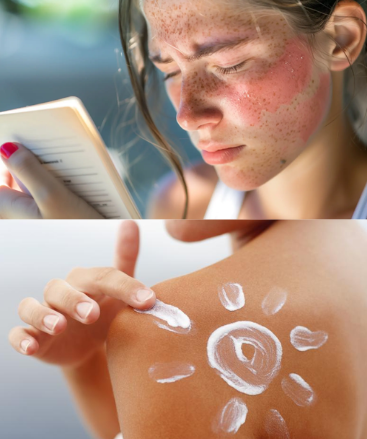
Having dry and sensitive skin can feel like walking on a tightrope—you’re always cautious about what you put on your face. One wrong product and your skin flares up with redness, itching, or peeling. Sunscreen, although essential, can be especially tricky. Many formulas are loaded with ingredients that trigger irritation and, surprisingly, also harm marine life. If you’ve ever wondered why your skin reacts to certain sunscreens or how your choices impact the environment, this guide breaks it all down for you.
Why Dry and Sensitive Skin Needs Special Sunscreen
Unlike normal skin, dry and sensitive skin struggles with barrier function. This means it loses hydration faster and reacts more easily to irritants. Sunscreens that contain harsh filters can worsen the problem, leaving your skin flaky, itchy, and red. But beyond your skin, some widely used UV filters are now proven harmful to coral reefs, fish, and even our food chain. Choosing the right sunscreen isn’t just self-care—it’s eco-care too.
Unsafe Sunscreen Filters to Avoid
Not all UV filters are skin-friendly. In fact, some of the most popular ones are linked to allergic reactions, hormone disruption, and coral bleaching. Let’s look at the top culprits.
Octinoxate (OMC)
Octinoxate, also known as octyl-methoxycinnamate, has been in sunscreens since the 1950s. While it does shield against UVB rays, studies show it’s toxic to coral reefs—even in tiny amounts. For humans, it’s been linked to hormonal imbalances, skin inflammation, redness, and acne flare-ups. So much so that Hawaii and Key West banned it for its environmental impact.
Oxybenzone
Often labeled as sunscreen’s “enemy number one,” oxybenzone penetrates the skin easily and lingers in your system. The Environmental Working Group (EWG) warns it can disrupt hormones, trigger allergies, and even show up in breast milk, urine, and blood. On top of that, it’s infamous for damaging coral reefs, making it both a personal and planetary concern.
Octocrylene
A newer UV filter, octocrylene, breaks down into benzophenone—a chemical suspected of being carcinogenic. It can also alter estrogen levels and has been linked to allergic skin reactions. Research shows it may even cause photoallergies, meaning it reacts negatively with sunlight itself. Definitely not a match for sensitive skin.
Video : HOW TO CHOOSE A SUNSCREEN FOR YOUR FACE |
PABA (Para-Aminobenzoic Acid)
Once widely used, PABA seemed safe because it occurs naturally in foods like milk and eggs. However, research revealed that under sunlight, it breaks down and releases free radicals that damage DNA. In fact, some studies suggested it might even increase the risk of sun-related cancers. For sensitive skin, this ingredient is a hard pass.
Safer Sunscreen Alternatives for Sensitive Skin
The good news? You don’t have to sacrifice sun protection for skin comfort or environmental safety. Modern, irritation-free filters are available and perform even better.
Tinosorb® S and Tinosorb® M
These advanced filters offer broad-spectrum protection against UVA, UVB, and even blue light from screens. Tinosorb® S is photostable (meaning it won’t break down in sunlight), while Tinosorb® M absorbs UV rays and converts them into harmless energy before reflecting them away. Both are gentle and highly effective for sensitive skin.
Prunus Yedoensis Leaf Extract
This natural extract not only protects the skin but also has anti-inflammatory and soothing properties. It calms redness and irritation, making it perfect for dry, reactive skin types.
Together, these alternatives keep your skin safe, comfortable, and hydrated while respecting marine ecosystems.
Tips for Using Sunscreen on Dry and Sensitive Skin
Choosing the right sunscreen is just the beginning. To maximize benefits without irritation, follow these simple steps:
- Check the labels: Look for terms like non-comedogenic, broad-spectrum, and O-free (free of oxybenzone and octinoxate).
- Hydrate first: Apply a lightweight, ceramide-rich moisturizer before sunscreen to create a barrier.
- Reapply often: Sunscreen fades, especially after swimming or exercising. Reapply every two hours for continuous protection.
- Choose higher protection: Aim for SPF 50 and PA+++ or above to defend against both UVA and UVB rays.
- Avoid over-layering: Stick to a simple routine with fewer active ingredients to reduce chances of irritation.
Video : Dermatologist Shares the Best Sunscreen for Your Skin Type (Oily, Dry, Combination, & More!)
Takeaway
Sunscreen is non-negotiable for healthy skin, but if you have dry and sensitive skin, choosing the wrong one can do more harm than good. Filters like octinoxate, oxybenzone, octocrylene, and PABA may protect against UV rays, but they come with a heavy price—for your skin and the planet. The solution? Switch to safer, eco-friendly alternatives like Tinosorb® S, Tinosorb® M, and soothing botanical extracts. By choosing wisely, you protect not just your skin’s health but also our oceans.
Your skin deserves comfort, hydration, and strong protection—without compromise. Next time you shop for sunscreen, remember: the right formula is out there, and it can keep both you and the planet glowing.


